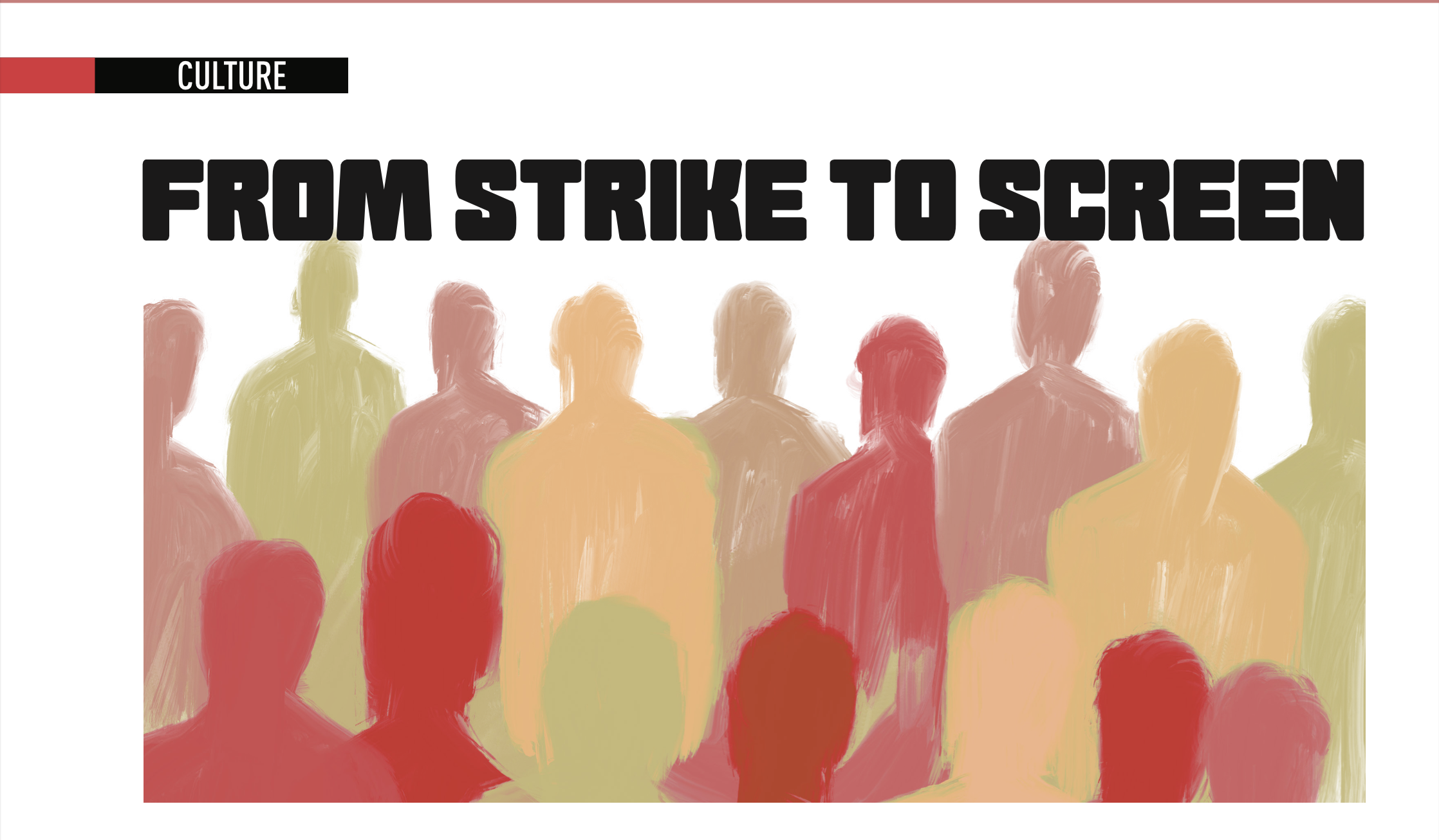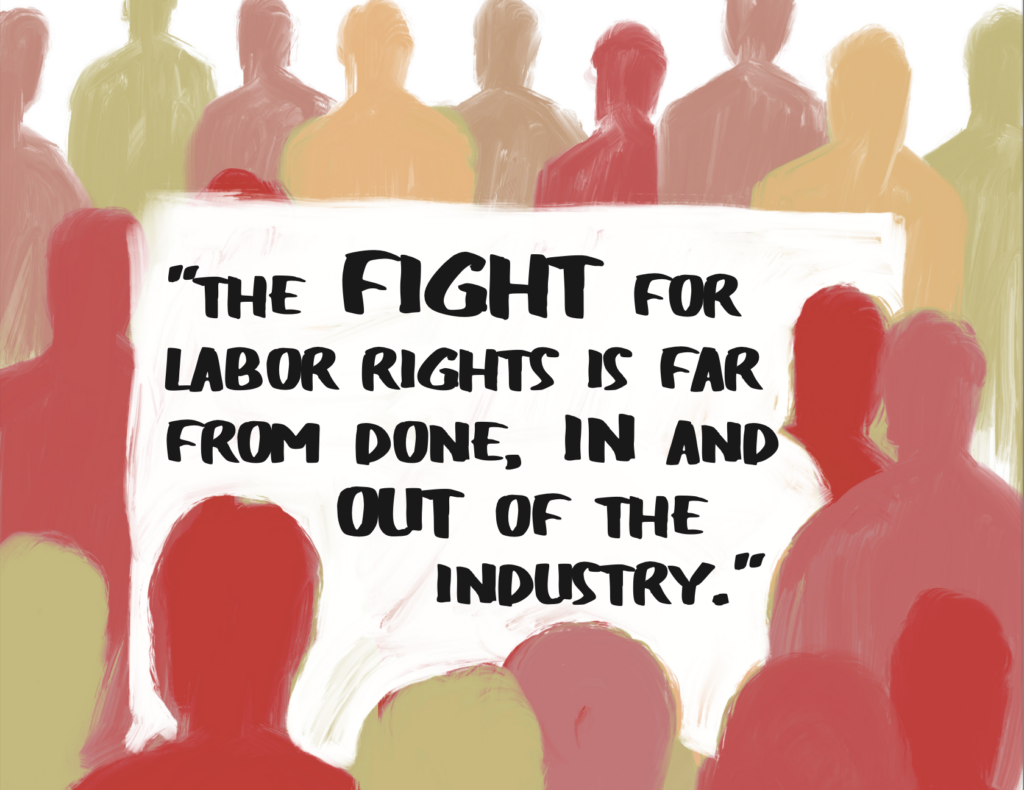
The Synopsis
Within the past year, the WGA and, later, SAG-AFTRA both went on strike — for anyone with their head under a rock, these strikes were the refusal to work until employers provide better working conditions — representing the screenwriters and actors of America. As an ATEC student interested in TV writing, and, perhaps more importantly, as one of the 80% of Americans who watch TV almost daily (Bureau of Labor Statistics 2018), this was important to me, just as it should be for everyone reading. Everyone should care about the condition of every labor issue in the U.S., but what makes these strikes so special is that they have a direct impact on the most popular form of American entertainment: TV. The strikes are both over — SAG-AFTRA finally reached a deal with studios just this past November — but the issues are far from gone. As people who more than likely also watch TV every day, I figure all of AMP’s readers deserve to know more about the issues faced by the people who make everyone’s favorite shows and movies, both revolving around the strikes and moving forward.
The Exposition
Before we get into the strikes from this year, however, I’d like to shine a bit of historical context on the situation. This is far from the first time strikes have happened for either the Writers’ Guild or the Screen Actors’ Guild, but it’s been over sixty-three years since both struck at the same time. The key issue then was the fact that producers under AMPTP — studios like MGM, Disney, Warner Bros., and today Sony, Netflix, Amazon, and Apple — were making bank off TV without sharing a proportional amount of the profits with the people who actually made the goddamn movies and shows, much like one of the key issues this year. The writers’ strike lasted 148 days for film workers, which happens to be the exact same number of days as this year’s, while the actors’ strike lasted 42 days. And, with both parties completely refusing to work, production on eight then-upcoming features halted, forcing production companies to come to the table despite their “completely uncompromising attitude,” as stated by Curtis Kenyon, the WGA president at the time. While the negotiations didn’t lead to much in terms of residuals on work from before the strike — residuals serving as the main form of pay for writers after a film or TV episode is released — residuals and contracts were increased for work done after the 1960 strikes, and pensions, healthcare, and welfare were all established, defining a massive success.
It wouldn’t be the only success in the coming decades, either. About once each decade until 1988, the WGA would go on strike and win more in residuals, base pay, creative control, and a handful of other protections related to changing times, such as residual adjustments based on cassettes, foreign markets, and in 2007-2008, digital releases/streaming. The first consistency across all of these strikes is that the writers found real results from the power in withholding labor, even as they resorted to sleeping in their cars and picketing in the heat. The second consistency is that the strikes happened as studios continually short-ended creators, especially with residuals. Furthermore, studios always looked for other ways out of negotiating; particularly in the 1988 and 2007-2008 strikes, Hollywood tried filling the gap with reality TV to fill the gap in revenue, which led to the genre’s rise. The studios soon realized, as everyone eventually does, that reality TV sucks, and had to go back to actual writers creating actually good content. Studios have also tried just continuing shows and film production without their vital writing crews, leading to active and noticeable dips in quality. In fact, let’s take a moment to just look at some of those impacts from the strike preceding this year’s.
Shows and Movies Affected by the 2007-2008 WGA Strike
- “The Office,” season 4 — Michael Scott’s character leaves the show, courtesy of Steve Carrell calling in sick with “enlarged balls” in solidarity.
- “Transformers: Revenge of the Fallen” — wound up with a heavily rushed script, as one could tell merely by watching the movie.
- “Breaking Bad,” season 1 — actually benefited from writing changes made because of the strike, as show creator Vince Gilligan originally planned to kill off the character of Hank Schraeder — one of the most engaging characters throughout the entire show. The season was also limited to seven episodes.
- “X-Men Origins: Wolverine” — the one with the shitty Deadpool with no mouth. Rushed script.
- “Pushing Daisies,” season 2 — critically acclaimed, until too much time between seasons made people not care anymore. Got canceled mid-season 2.
And, of course, this isn’t to discount the dozens of shows that simply had episodes cut, such as “iCarly,” “Scrubs,” “Grey’s Anatomy,” “Bones,” “Family Guy,” and many more.
SAG-AFTRA went on strike as well during these decades after the ‘60s, albeit fewer times against Hollywood — although one of its strikes against the American Association of Advertising Agencies did get rated the 6th largest strike in America by USA Today in 2020, showing the perpetuity of the guilds’ staying power, collectively. All of this to say, when both the WGA and SAG-AFTRA went on strike this year, given the history, it was a big deal. It was the first time either had been on strike since 2008, and it’s a pretty big red flag that the studios weren’t giving the writers and actors their fair shake. And this year, that took shape in a lot of different ways.
The Inciting Incident
I’ve been writing creatively for years now, and I can pretty easily speak for creators of all kinds when I say that creatives are ridiculously exploitable. We love what we do, and I’m far from the first person to say I’d continue writing for the rest of my life for free, no matter how everything else goes. And, based on the way studios keep trying to skimp out of paying for the valuable labor that goes into entertainment, the studios clearly know this. As such, the fact that residuals were once again one of the key issues this year comes without any surprise. Back in June, Spencer Rothbell, a writer for Netflix-original “12 Forever” and a the previous head-of-story for “Clarence,” tweeted (Xeeted? Posted? Elon Musk is a huge loser) a screenshot of one of his residual payments for $8.57. Many other writers and actors reported seeing less than half this much — with some checks coming in at actual pennies. Perhaps the most iconic of these examples is one of Kimiko Glenn’s TikToks during the strikes, where she shows off her residuals as a recurring character for almost half of the episodes in the widely acclaimed, award-winning series “Orange is the New Black.” Despite checks listed for dozens of episodes, the payment only amounted to $27.30, with several showing payments of anywhere between $0.01 and $0.04. This is something relatively unique to the streaming era, as residuals used to be calculated based on the number of views for cable, or cassette/DVD sales, etc. in addition to the labor and success surrounding the end product. According to the Washington Post, this system used to be able to pay a person’s bills, depending on the circumstances (Anders 2023). With streaming, residuals are calculated based on the number of subscribers under a streaming platform as opposed to views or any metric of success specific to an individual piece of media, which has the perhaps egalitarian claim of leveling the playing field for popular and unpopular shows, but truly means CEO’s and other executives at the big studios can undercut residuals to line their own pockets, leading to the pitiful numbers above even for popular releases.
Residuals are not the only way writers and actors earn money, however. Another key issue, at least for writers, was contracts; while most people look for year-round employment, writers and actors enter into contracts for weeks at a time until production on a show or movie is finished or the contract expires and is not renewed. Major actors must obviously be on a production from start to finish, with exceptions, but writers had little job security preceding the strikes. Writers used to have shorter contracts, and fewer writers were required to be on staff. This meant fewer weeks of employment, fewer people being employed, and overall a lot of uncertainty about one’s income throughout the year. Additionally, the timing of payments were inconsistent, with many writers and actors on TikTok, Instagram, what was formerly Twitter, and other social media sites speaking up about how they had to frequently send emails in order to get paid any of what they were owed for their work. Michael Jamin, a TV veteran with numerous credits including five years on “King of the Hill,” even posted in July on his Instagram about how the classification of “qualified earnings,” which determine whether a writer qualifies for health insurance, were timed and classified deliberately to prevent people from qualifying for health insurance.
Finally, one of the biggest concerns giving rise to the strikes is AI. AMPTP studios actively pushed for the use of AI like ChatGPT and the plethora of AI art generators in order to write and visualize stories with fewer human employees, and some AI are even capable of emulating a real person’s voice and image, as was the case for the box-office flop “The Flash” (2023) and (spoilers) “The Mandalorian” second season’s cameo of a young Luke Skywalker. Not even addressing the fact that Disney found the perfect guy to just…play…Luke, nor the ethical issues of puppeting dead actors like in “The Flash,” the threat of AI stands to render writers obsolete and actors’ visages stolen in a move that both profits off of and discards creatives in a creative industry, a fact ever the more true given that the databases these AI use to make all of their work are saturated with the work of real people. AMPTP stood poised to strip artists from their art, taking out the human element of emotion and experience that defines the TV and films people go home to enjoy for three hours per day (Bureau of Labor Statistics 2018), and as many people on strike pointed out, ending the current and future careers the strikes were for.
The Rising Action
With these problems in mind, the writers and actors took to the picket lines. After that, a few simple facts. AMPTP refused to provide a deal the WGA found acceptable for 148 days, and for SAG-AFTRA 118 days. AMPTP cut the trees providing shade over picket lines during searing summer heat. AMPTP planned “to allow things to drag on until union members start losing their apartments and losing their houses.” AMPTP incurred billions in economic losses according to Vanity Fair when the WGA estimated initial demands would have cost roughly $300-$400 million, or about the same as Warner Bros. Discovery lost in this year’s earnings alone. And, in spite of studio execs making comments, like Disney CEO Bob Iger’s assertion the writers and actors were being “unrealistic” and “disruptive,” the American public stood behind the strikes at a rate of 75% support from AFL-CIO’s estimate. Because, as it turns out, it’s very difficult to tell people who come home from a long day at work to watch TV and check social media that the people who make that TV and post about their struggles on social media (shoutout to Adam Conover) are the villains against a handful of people who could pay someone to hand-pick and hand-feed them grapes 24/7.
The Climax
Literally the only thing going for the WGA and SAG-AFTRA was morale and community. There is little fun nor comfort to be found on a picket line in the heat besides the fact that the writers and actors had the support of their audiences, family, and friends, and that they were fighting for the benefit of current and future people in their professions. Thanks to this, however, AMPTP caved to the WGA at the end of September, and then again to SAG-AFTRA just last month, with almost all of the demands being met for both. This means higher residuals (including a viewership bonus for streaming), a minimum number of staff writers with 10-week minimums for contract length, and AI protections in writing and acting, with the one catch of an “exceptions to consent” clause in the actors’ agreement. For today, the professions live a little longer, because of the people brave enough to withhold their labor and fight back against companies’ exploitations. However, none of it would have been possible without widespread support from people on the sidelines, and the repeated successes of these unions shows a key element of how unbreakable the entertainment industry’s labor is, particularly considering their role in making a little something for audiences to enjoy every day.
The Resolution
At the time of writing, the dust is still settling, and SAG-AFTRA members haven’t even voted on the new agreement yet. The hole in the AI protections clause still makes actors feel unsafe in a way that cannot be ignored, but for now the worst of the studios’ exploitations are abated. However, while these strikes were unique in what they gain as part of the entertainment industry, plenty of other strikes are going on right now that deserve just as much support. Teachers, baristas, auto workers, soon possibly flight attendants — many industries in the U.S. right now are fighting for their rights, and one of the benefits of the writers’ and actors’ success is that it can and should inspire other important pillars of our society to ensure fair compensation for their labor! Even within the entertainment industry, VFX artists, especially the ones at Marvel who were rushed into churning out whatever happened in the recent Ant-Man movie and various TV shows, also recently voted to unionize, so be sure to support them in whatever they do. The WGA and SAG-AFTRA strikes are over, but the fight for labor rights is far from done, in and out of the industry.


Comments